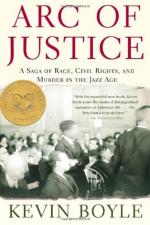
|
| Name: _________________________ | Period: ___________________ |
This test consists of 15 multiple choice questions and 5 short answer questions.
Multiple Choice Questions
1. What was the mayor's surname?
(a) Winchester.
(b) Sweet.
(c) Black.
(d) Smith.
2. Who finally admitted to finding a stone in the house?
(a) Schuknecht.
(b) Adler.
(c) Mahoney.
(d) Perry.
3. How was Sweet referred to in the media?
(a) A face of the future.
(b) A pompous upstart.
(c) A martyr.
(d) A reluctant hero.
4. Toms stated that the men must have been looking for which of the following?
(a) Confrontation.
(b) Equality.
(c) Cause.
(d) Retribution.
5. Where were Sweet and the other men taken?
(a) Commissioner's office.
(b) Mayor's office.
(c) Detective's Bureau.
(d) Federal building.
6. The inspector had how many reinforcements to help control the mob on Garland Avenue?
(a) 200.
(b) 300.
(c) 100.
(d) 75.
7. How many people crammed into the area around the house?
(a) 3,000.
(b) 500.
(c) 1,500.
(d) 5,000.
8. What was Springarn's first name?
(a) Arthur.
(b) Edmond.
(c) Anderson.
(d) Edgar.
9. Which of the following was missing from the court room when Darrow and Hays argued to dismiss?
(a) Prosecution.
(b) Jury.
(c) Judge.
(d) Defendants.
10. What did Sweet do while awaiting a new trial?
(a) Practiced medicine.
(b) Spent time at home repairing the house.
(c) Studied for bar exam.
(d) Traveled.
11. Who went with the inspector through the Sweets' house?
(a) Perry.
(b) Chief of police.
(c) Sweet.
(d) Reporter.
12. The NAACP believed that which of the following was unnecessary?
(a) Catered lunches.
(b) Chauffered cars.
(c) Four star hotels.
(d) Three local lawyers.
13. What was the outcome of the case?
(a) Hung jury.
(b) Guilty.
(c) Mistrial.
(d) Acquittal.
14. The organization was found to be guilty of what?
(a) Fixing an election.
(b) Lying to a federal court officer.
(c) Compromising the jury.
(d) Advocating violence.
15. The minister organized a group focused on which of the following?
(a) Community involvement.
(b) Racial non-violence.
(c) Political campaign.
(d) Raising funds.
Short Answer Questions
1. Who presented the defendants with a document that awaited their signatures?
2. What group was eliminated from jury selection?
3. The defense succeeded in having charges dropped against which defendant?
4. Who spoke to the men about the guns and ammunition?
5. What document was objected to by Hays?
|
This section contains 314 words (approx. 2 pages at 300 words per page) |

|




